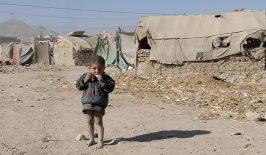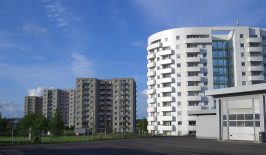From raging wildfires in Turkey to devastating floods in Germany, the climate crisis is already catalysing a surge in natural disasters. As the number of catastrophes soars, more and more people who have been displaced or lost their homes need emergency shelter. That’s why architectural duo Gisue Hariri and Mojgan Hariri have designed a pop-up pod that can comfortably house people in crisis at the push of a button.
Providing shelter is a key tenet of humanitarian response, but it’s rarely straightforward. Tents and tarps are just short-term solutions, but in the midst of a crisis, more permanent structures often can not be built quickly enough. Given the chaotic and unstable nature of humanitarian emergencies, questions about how to best ensure the privacy and dignity of displaced people abound.
In an attempt to target some of the pains associated with emergency shelter, New York-based firm Hariri & Hariri have created a flat-pack, prefabricated housing pod. These pods are designed for easy assembly, affordability, and sustainability – a winning combination, at least in theory.
As with the rest of the firm’s broad portfolio of architectural work, these pods are sleek and stylish, but they’re also highly practical. Conceptually inspired by the art of origami, the blueprints resemble a simple pop-up cardboard box.
No extra hardware or tools are required to assemble these lightweight shelters, which are foldable to facilitate quick and convenient shipping. “In the middle of a hurricane, you don’t have time for a screwdriver,” Gisue Hariri has said. They are also modular and can be linked together to create larger units. As is illustrated by the many renderings on the firm’s website, the portable structures are airy and bright, offering natural light and ventilation.
The building materials are intended to be easily accessible for governments or humanitarian organisations under time pressure. The panels are currently constructed from glass and equitone panels, though the creators are also experimenting with the use of carbon fibre.
For the Iranian-born sisters behind Hariri & Hariri Architecture, having a safe space of one’s own is a problem that is, very literally, close to home. Inspired by their own experiences of leaving their home in Iran, they seek to fulfil architecture’s social responsibility to provide living spaces for all.
The ongoing pandemic has also thrown up another urgent use for the pods: the need for emergency structures outside hospitals in regions with high hospitalisation rates.
While the sisters had disaster relief in mind when designing the pods, they can also be used as sustainable alternatives to holiday housing, beach cabanas, or temporary “villages” for festivals. Despite the humanitarian emphasis of the project, the current imagery of the pods seems skewed towards their use as luxury homes, rather than reflecting the realities of humanitarian disasters.
The goal of the firm is to implement these pods globally, with roll-out heavily dependent on funding. But there have been some promising developments on that front: the firm recently received a breakout grant from NYCxDesign for the project.








